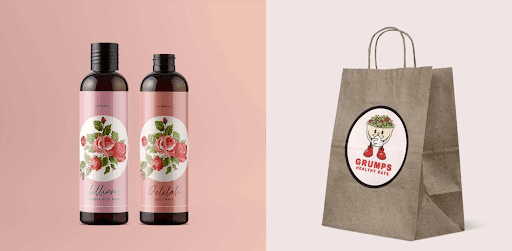Business
Paper vs. Synthetic: Selecting The Right Material For Your Label

You are very close to launching a new product and have spent months, perhaps years, perfecting the formula, design, and packaging. Now, you’re down to one of the final decisions – what material should your label be?
This choice might seem like a minor decision compared to others, but it’s the face of your product. It’s what customers see first and remember most.
You wonder, “Should I go for the classic appeal of paper, or the durability of synthetic labels?” This decision feels daunting, not just because of the aesthetic implications but because it directly impacts your product’s shelf appeal, durability, and even environmental footprint.
This is where we step in to help. We will assist you make informed decisions about label materials, balancing cost, design, durability, and sustainability. By the end of this article, you’ll understand the pros and cons of paper versus synthetic labels and get practical advice on choosing the right material for your specific needs.
So, let’s start without any delay.
Table of Contents
A Study Of Paper Labels
Paper labels are made from wood pulp and offer a traditional look and feel, often associated with organic or artisanal products. However, its benefits are not just limited to aesthetics.
Paper labels offer various advantages, making them a popular choice for various applications. To determine if they are the right fit for your labelling needs, it’s important to understand their benefits.
Advantages Of Using Paper Labels
Here are some key benefits of using paper labels:
Wide Range Of Colours
One of the main advantages of paper labels is that they are available in a wide range of colours. Paper labels are found in all colour schemes, from bright and pop fluorescent colours to soothing pastel shades. If you work with a seasoned label printer, you can also request custom colours for your paper labels.
Ink Adhesion
Paper has better printability than synthetic labels, meaning the former can withstand high-heat printing. Paper labels under high-heat printing can hold the ink well, resulting in sharper prints.
Cost-Effectiveness
One of the most significant advantages of paper labels is their cost-effectiveness. Paper is generally less expensive to produce and purchase than synthetic materials. This makes paper labels an excellent option for businesses looking to minimise packaging costs without sacrificing quality.
Environmental Friendliness
Most paper labels are biodegradable, making them an eco-friendly option for brands committed to sustainability. Additionally, many paper labels can be recycled, further reducing their environmental impact.
Drawbacks Of Using Paper Labels
While paper labels offer numerous benefits, there are also some disadvantages to consider as well. Understanding these drawbacks can help ensure you make an informed decision.
Here are some key disadvantages of using paper labels:
Sensitive To Moisture
Paper labels are very sensitive to moisture and water. When exposed to liquid, paper labels can easily become soggy, tear, or even disintegrate, compromising the label’s integrity and the readability of the printed information.
This makes them less suitable for products requiring refrigeration or likely to be exposed to wet conditions, such as beverages or bath and beauty products.
Limited Durability
Compared to synthetic labels, paper labels generally offer less durability. They are more prone to wear and tear, fading, and damage from environmental factors such as UV light.
This can affect the longevity of the label’s appearance and legibility, making it a bad choice for products that undergo rough handling, have long shelf lives, or withstand outdoor exposure.
Vulnerability To Stains And Grease
Paper labels can easily absorb oils, grease, and other substances, leading to stains that can spoil the label’s appearance. This can pose a significant challenge for products in the food, automotive, or industrial sectors where oils and greases are common.
Understanding Synthetic Labels
Synthetic labels, on the other hand, are crafted from plastics like polyethylene, polypropylene, and vinyl. Out of these variants, polypropylene labels, also known as BOPP, are the most common synthetic label in the market.
Pros Of Using Synthetic Labels
Let’s see how using Synthetic Labels can help your product and brand.
Resistance To Water
Synthetic labels are best suited for products that are exposed to any kind of moisture, be it water, steam, or condensation. From wine bottles in ice baths to chemical drums kept in outdoor storage, synthetic labels are perfect for products that are exposed to harsh weather or damp and moist conditions.
High Durability And Resistance
Synthetic labels are highly resistant to various environmental conditions. They can withstand moisture, oil, chemicals, and UV exposure without disintegrating. This makes them ideal for products stored outdoors or in harsh conditions. This durability ensures that the label remains legible and intact throughout the product’s life cycle.
Optimum Security Features
You can place security features like holograms, tamper-evident seals, and RFID tags on synthetic labels that enhance product authenticity and consumer safety. This makes them an excellent choice for high-value items or products prone to counterfeiting.
Chemical And Abrasion Resistance
Synthetic labels are also resistant to chemicals and abrasion, ensuring they don’t smudge, fade, or wear away when exposed to harsh substances or physical wear and tear.
This feature is particularly beneficial for industrial products, automotive parts, and other items that may come into contact with oils, solvents, and other chemicals.
Cons Of Using Synthetic Labels
While synthetic labels offer numerous advantages, there are also several disadvantages to consider as well.
Here are some key disadvantages of using synthetic labels:
Environmental Impact
One of the most significant drawbacks of synthetic labels is their environmental impact. Most synthetic labels are made from plastics such as polyethylene (PE), polypropylene (PP), and polyester (PET), which are not biodegradable.
This means they can contribute to plastic pollution and are more challenging to dispose of in an environmentally friendly manner.
Heat Sensitivity
Certain synthetic materials can be sensitive to extreme heat, which can cause labels to warp, shrink, or melt during application processes or when exposed to high temperatures in use.
Cost
Synthetic labels can be more expensive than paper labels. The materials, printing and application processes can incur higher costs. Consider this factor if you are operating on tight margins or prioritise cost-effectiveness in packaging.
How Do You Choose The Right Label For Your Needs?
You must carefully consider various factors before choosing the label material for your product. This ensures that the material works well under the conditions the product will be exposed to.
Let’s discuss some key factors to consider when selecting the right label for your needs.
Product Environment
- Take into regard the conditions your product will be exposed to daily, such as moisture, temperature extremes, sunlight, and chemical exposure.
- This will determine whether you choose durable synthetic labels or eco-friendly paper labels.
Durability Needs
- Assess how long the label needs to last and what types of wear and tear it might encounter.
- A synthetic label might be necessary if your product is outdoors or in harsh conditions.
Aesthetic And Design Requirements
- Think about the look and feel you want for your product.
- Paper labels offer a classic, natural appearance, while synthetic labels can provide a sleek, modern look with a wide range of finishes.
Environmental Impact
- If environmental friendliness is your brand’s core value, paper labels might align more closely with your goals and explore eco-friendly synthetic options.
Budget Constraints
- Keep in mind your budget for product labelling.
- Paper labels are generally less expensive than synthetic ones but also factor in the long-term costs associated with label durability and replacement.
Choosing the right label for your product is not just about the appearance of your product but also its marketability. By carefully considering these factors and asking the right questions, you can select a label that best meets your needs and aligns with your brand values.
Final Words – Label That Matters
Selecting the right label material – paper or synthetic – is a crucial decision that affects your product’s presentation, durability, and environmental impact.
Take the time to assess your options and choose a label that truly represents your product and brand. This thoughtful approach will serve you well in the competitive marketplace, helping to ensure your product stands out for all the right reasons.

-

 Business3 years ago
Business3 years agoHow to Do Long-Distance Moves with Children
-

 Business2 years ago
Business2 years agoThe Ultimate Guide To Thriving In Your Printing Franchise
-

 Business2 years ago
Business2 years agoExploring The Benefits And Challenges Of Restaurant Franchising
-

 Travel2 years ago
Travel2 years agoQuick Guide: Moving To Santa Rosa?
-

 Business4 years ago
Business4 years agoIs Guest Posting a Good Inbound Marketing Strategy?
-

 Real Estate3 years ago
Real Estate3 years agoWhy Dubai Festival City is a Great Neighbourhood for Young Learners
-

 Lifestyle2 years ago
Lifestyle2 years agoDallas’ Hidden Gems: 6 Must-Try Restaurants Off The Beaten Path!
-

 Lifestyle2 years ago
Lifestyle2 years agoTop 10 Restaurant Franchises In The US











Recent Comments